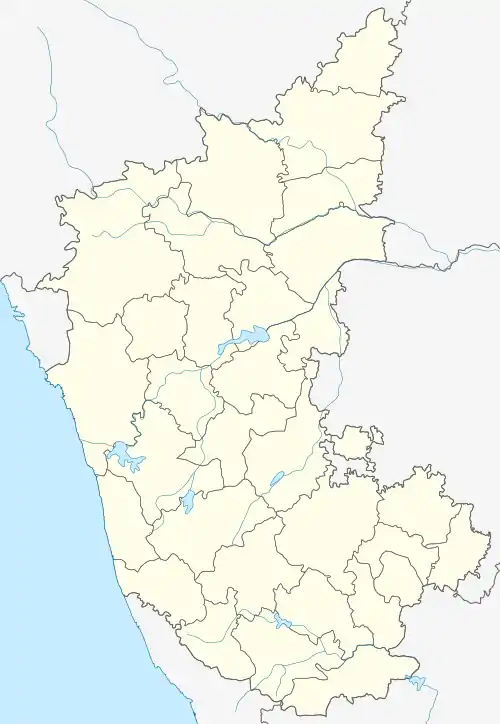Hampi (town)
Hampi is a town in Hospet taluk of the Vijayanagara in the Indian state of Karnataka.[2] Located along the Tungabhadra River in the east and center part of the state, near the border of Andhra Pradesh, Hampi is near the city of Hosapete. It is famous for hosting the Hampi Group of Monuments, a UNESCO World Heritage Site.[3]
Hampi | |
|---|---|
Town | |
 | |
 Hampi | |
| Coordinates: 15.335°N 76.462°E | |
| Country | |
| State | Karnataka |
| District | Vijayanagara |
| Elevation | 467 m (1,532 ft) |
| Population (2011) | |
| • Total | 2,777[1] |
| Languages | |
| • Official | Kannada |
| Time zone | UTC+5:30 (IST) |
| PIN code | 583239 |
| Nearest city | Hosapete (Hospet) |
Hampi is mentioned in Ashokan epigraphy and texts such as the Ramayana and the Puranas of Hinduism as Pampaa Devi Tirtha Kshetra.[4][5][6] Hampi was a part of Vijayanara, the capital of the Hindu Vijayanagara Empire in the 14th-century.[4][7] It became a center of economic and administrative activity of the Deccan region kingdom founded in opposition to Islamic Sultanates in South India. After over two centuries of rule, the Empire was defeated and destroyed by a coalition of Sultanates. Hampi was in ruins and abandoned. Since the 19th-century, its ruins became an important site for archaeologists and historians.[7][8]
Geography
Hampi is situated on the banks of the Tungabhadra River, midst rocky hills. It is 348 kilometres (216 mi) from Bangalore, 385 kilometres (239 mi) from Hyderabad and 266 kilometres (165 mi) from Belgaum. The closest railway station is in the city of Hosapete (Hospet), 13 km away.
Economic activity
The principal economic activity in and around the town include agriculture, tourism and industrial activity related to iron ore, manganese and other minerals mining. The average rainfall around Hampi town is about 660 mm. The major crops grown are paddy, maize, jowara, bajra, groundnut, sunflower, sugarcane and cotton. Part of the Hampi farmlands are irrigated and there is a large dam nearby.[2]
Tourism
Hampi hosts, in part, a group of monuments that UNESCO has declared a world heritage site.[3]
In and after the 1960s, the town became an attraction for motorbikers and a site for offbeat tourism when its infrastructure was in poor state. Groups of tourists would gather on its hills and midst its ruins, to hold parties and spiritual retreats, and these have been called "Hampi Hippies" and Hampi as the "lost city" in some publications.[9][10]
The annual Hampi Utsav or "Vijaya Festival" has been celebrated since the reign of Vijayanagara. It is organized by the Government of Karnataka as Nada Festival.[11] more than 1 million people visit this place.
Climate
| Climate data for Gokarna | |||||||||||||
|---|---|---|---|---|---|---|---|---|---|---|---|---|---|
| Month | Jan | Feb | Mar | Apr | May | Jun | Jul | Aug | Sep | Oct | Nov | Dec | Year |
| Average high °C (°F) | 30.9 (87.6) |
33.5 (92.3) |
36.5 (97.7) |
37.9 (100.2) |
37.5 (99.5) |
33.2 (91.8) |
30.8 (87.4) |
31.0 (87.8) |
31.2 (88.2) |
31.4 (88.5) |
30.5 (86.9) |
29.9 (85.8) |
32.9 (91.1) |
| Average low °C (°F) | 18.1 (64.6) |
19.9 (67.8) |
22.5 (72.5) |
23.6 (74.5) |
24.9 (76.8) |
23.9 (75.0) |
23.3 (73.9) |
22.9 (73.2) |
22.5 (72.5) |
21.9 (71.4) |
19.9 (67.8) |
17.8 (64.0) |
21.8 (71.2) |
| Average precipitation mm (inches) | 0 (0) |
0 (0) |
2 (0.1) |
24 (0.9) |
58 (2.3) |
61 (2.4) |
87 (3.4) |
90 (3.5) |
129 (5.1) |
123 (4.8) |
25 (1.0) |
16 (0.6) |
615 (24.1) |
| Source: Climate data: Hampi | |||||||||||||
References
- "Hampi Village Population - Hospet - Bellary, Karnataka". Census2011.co.in. Retrieved 11 August 2015.
- Ballari:Hospet:Hampi, Official Website of Ballari District, Government of Karnataka
- "Group of Monuments at Hampi". World Heritage. Retrieved 20 December 2006.
- Anila Verghese (2002). Hampi. Oxford University Press. pp. 1–18. ISBN 978-0-19-565433-2.
- John M. Fritz; George Michell; Clare Arni (2001). New Light on Hampi: Recent Research at Vijayanagara. Marg Publications. pp. 1–7. ISBN 978-81-85026-53-4.
- D. Devakunjari. World Heritage Series: Hampi. Eicher Goodearth Ltd, New Delhi - for Archaeological Survey of India. p. 8. ISBN 81-87780-42-8.
- John M. Fritz; George Michell (2015). Hampi Vijayanagara. Jaico Publishing. pp. 11–23, backpage. ISBN 978-81-8495-602-3.
- Joan-Pau Rubiés (2002). Travel and Ethnology in the Renaissance: South India Through European Eyes, 1250-1625. Cambridge University Press. pp. 234–236. ISBN 978-0-521-52613-5.
- Bill Aitken (1999). Divining the Deccan: A Motorbike to the Heart of India. Oxford University Press. pp. 219–221. ISBN 978-0-19-564711-2.
- David Hatcher Childress (1985). Lost Cities of China, Central Asia, and India: A Traveler's Guide. Adventures. pp. 186–187. ISBN 978-0-932813-00-8.
- "Hampi Utsav | Hampi Festival | Vurupaksha Temple". Karnataka.com. 9 January 2015. Retrieved 11 August 2015.
- S.Srinivasachar, T.S.Satyan, Hampi : The fabled capital of the Vijayanagara Empire, (Directorate of Archaeology and Museums), Govt. of Karnataka, 1995
External links
| Wikivoyage has a travel guide for Hampi. |